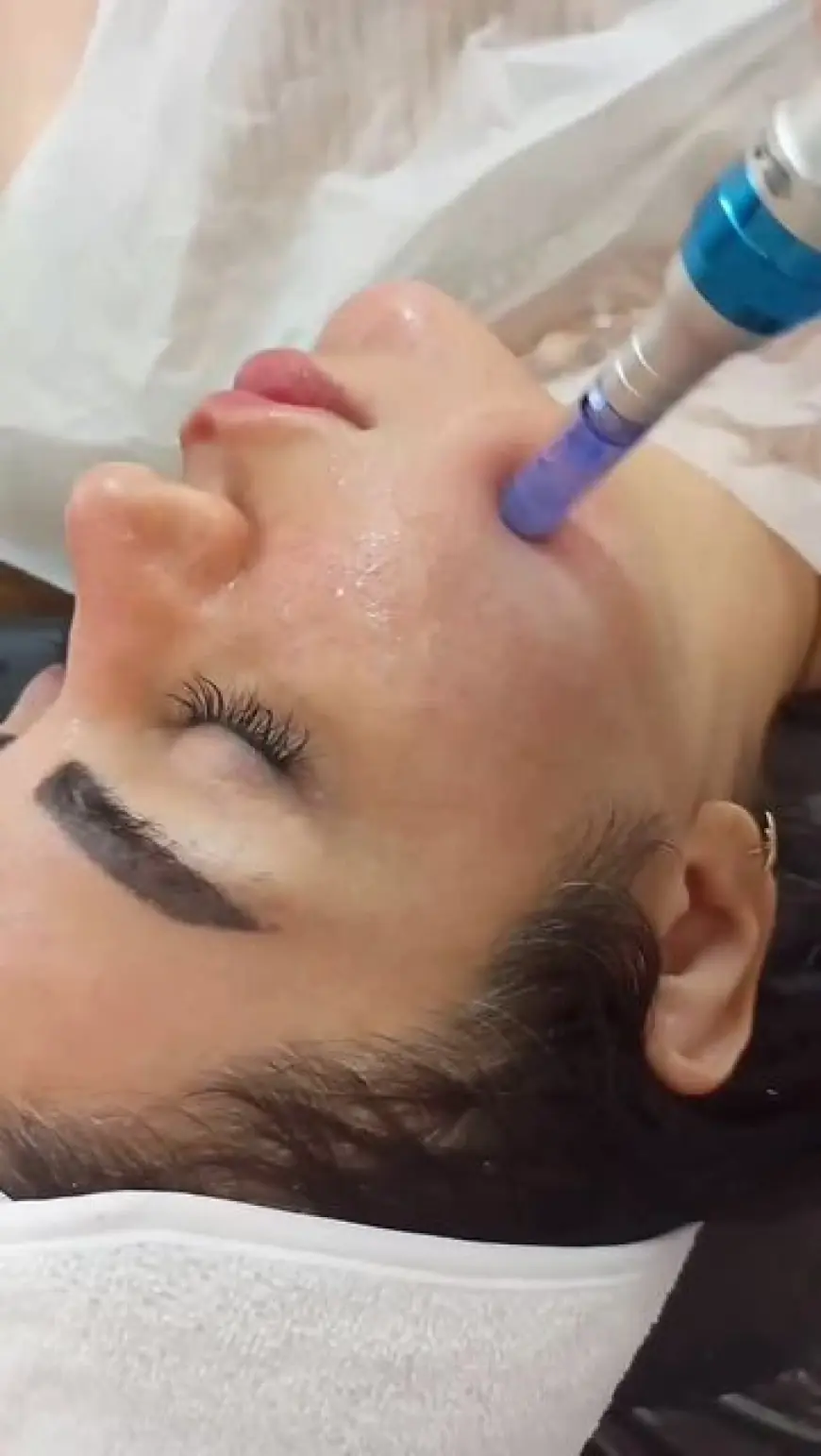Derma Pen for Melasma – Does It Help?
For those seeking solutions, particularly in the realm of advanced skincare, the question often arises: "Does Derma Pen micro-needling offer a viable treatment option for melasma?"

Melasma is a common and often frustrating skin condition characterized by brown, grayish-brown, or bluish-gray patches, primarily on the face. Often dubbed the "mask of pregnancy," it's more prevalent in women, particularly during hormonal shifts like pregnancy, or when taking birth control pills. While harmless, melasma can significantly impact self-confidence due to its prominent appearance. For those seeking solutions, particularly in the realm of advanced skincare, the question often arises: "Does Derma Pen micro-needling offer a viable treatment option for melasma?"
The Complexities of Melasma
Unlike typical sun spots, melasma involves an overproduction of melanin (skin pigment) by melanocytes, often triggered by a combination of factors. These include sun exposure (UV and visible light), hormonal changes, genetic predisposition, and sometimes even heat. Melasma can be epidermal (surface-level), dermal (deeper), or a mix of both, which influences how it responds to different treatments. Its stubborn nature means that effective management often requires a multi-faceted approach.
The Rise of Micro-Needling
Micro-needling, using devices like the Derma Pen, has gained significant popularity in aesthetic dermatology for its ability to address a wide range of skin concerns, from acne scars and wrinkles to overall skin texture and tone. This minimally invasive procedure works by stimulating the skin's natural healing processes. The question then becomes, can this collagen-inducing therapy effectively target the unique mechanisms behind melasma?
How Derma Pen Works and Its Potential for Melasma
The Derma Pen is an advanced micro-needling device that creates controlled micro-injuries in the skin. This process, known as Collagen Induction Therapy (CIT), triggers the body's natural wound-healing response. While primarily known for boosting collagen and elastin, the mechanics of micro-needling offer several pathways that can be beneficial in the treatment of melasma.
The Mechanism of Micro-Needling
A Derma Pen utilizes multiple fine, sterile needles that rapidly puncture the skin's surface at controlled depths.
-
Controlled Micro-Injuries: These tiny punctures are essentially controlled micro-traumas. They are too small to cause significant damage but sufficient to activate the skin's natural repair mechanisms.
-
Collagen and Elastin Production: The healing response initiates a cascade of events, including the production of new collagen and elastin fibers. This process helps to strengthen the skin's structure and improve its overall health.
-
Enhanced Product Penetration: The micro-channels created by the needles act as pathways, significantly increasing the absorption of topical serums, lightening agents, and other active ingredients applied during or immediately after the procedure. This allows these beneficial compounds to penetrate deeper into the skin where they can be more effective.
-
Cell Turnover and Pigment Dispersion: By stimulating the skin's regenerative processes, micro-needling encourages the shedding of old, pigmented skin cells and the generation of new, healthier cells. This accelerated cell turnover can help in the dispersion and removal of excess melanin.
Derma Pen's Potential Benefits for Melasma
When applied to melasma, the Derma Pen's actions can contribute to improvement through several mechanisms:
-
Exfoliation and Epidermal Melanin Shedding: The micro-needling process encourages the exfoliation of the outermost layers of the skin, where much of the epidermal melasma pigment resides. This helps to shed pigmented cells and reveal lighter, less pigmented skin underneath.
-
Disruption of Melanogenesis (Pigment Production): While research is ongoing, it's believed that the controlled trauma and subsequent healing response can positively influence melanocyte activity. By promoting a more normalized cellular function, the aim is to regulate melanin production, rather than overproduction.
-
Improved Penetration of Topical Agents: This is one of the most significant advantages for melasma. Melasma often requires potent lightening agents. The micro-channels created by the Derma Pen allow these agents (such as tranexamic acid, vitamin C, or specific depigmenting serums) to reach deeper layers of the skin, enhancing their efficacy significantly compared to topical application alone.
-
Reduced Risk for Darker Skin Tones: Unlike some laser treatments that can sometimes lead to post-inflammatory hyperpigmentation (PIH) in darker skin types, micro-needling is generally considered safer for a wider range of skin tones, as it causes less thermal damage. This makes it a valuable option for melasma, which is more common in individuals with medium to darker skin types.
While the Derma Pen offers a promising avenue for melasma treatment, it is usually most effective when part of a comprehensive treatment plan, often combined with specialized topical products and strict sun protection.
Treatment Protocols and Expected Outcomes
Successfully treating melasma with a Derma Pen involves more than just a single session; it typically requires a series of treatments delivered according to specific protocols, coupled with diligent aftercare. Understanding this structured approach is key to setting realistic expectations for the outcome.
The Treatment Series: Consistency is Key
-
Multiple Sessions: Melasma, being a persistent condition, rarely resolves with just one micro-needling session. A typical treatment plan involves a series of sessions, often 3 to 6, spaced 4 to 6 weeks apart. This allows the skin ample time to heal and regenerate between treatments, building progressive improvement.
-
Customized Needle Depth: A professional Derma Pen allows for adjustable needle depths. The practitioner will customize the depth based on the severity and type of melasma (epidermal vs. dermal), as well as the specific area being treated (e.g., thinner skin around the eyes versus thicker skin on the forehead). This precision ensures optimal results while minimizing downtime.
-
Synergistic Serums: During and immediately after a Derma Pen session, specialized serums are applied to the skin. For melasma, these often include ingredients like tranexamic acid, vitamin C, kojic acid, or other depigmenting agents. The micro-channels created by the Derma Pen allow these ingredients to penetrate deeply, maximizing their therapeutic effect.
What to Expect During and Immediately After Treatment
-
Comfort Level: A topical numbing cream is applied before the procedure to ensure comfort. Most patients report feeling a vibrating sensation and some pressure, rather than significant pain.
-
Immediate Post-Treatment: Immediately after the Derma Pen session, your skin will appear red, similar to a moderate sunburn. There might also be some mild swelling and a feeling of warmth or tightness.
-
Downtime: The redness usually subsides within 24-48 hours. Most individuals can resume normal activities within 1-2 days, although mild pinkness might linger for a few days. Makeup can usually be applied after 24 hours.
Anticipating Results and Long-Term Management
-
Gradual Improvement: Results from Derma Pen treatments for melasma are not instantaneous. You will notice gradual improvement with each session as the pigmented cells are shed and new, healthier skin emerges. Significant improvement typically becomes visible after 3-4 sessions.
-
Long-Term Sun Protection: This is paramount for melasma management. Without strict sun protection (daily broad-spectrum SPF 30+, reapplication, and protective hats), melasma is highly likely to recur or worsen, regardless of treatment. Sun avoidance during peak hours is also crucial.
-
Home Care Regimen: Your practitioner will recommend a tailored at-home skincare regimen, including gentle cleansers, hydrating serums, and specific lightening creams. Consistent home care complements in-clinic treatments and helps maintain results.
-
Ongoing Vigilance: Melasma is often a chronic condition that requires ongoing management. While Derma Pen can significantly reduce its appearance, periodic maintenance sessions and continuous sun protection may be necessary to keep it at bay.
By adhering to professional protocols and committing to a diligent home care routine, individuals can achieve noticeable and satisfying improvements in their melasma with Derma Pen treatments.
The Role of Aftercare and Complementary Therapies
The success of Derma Pen for melasma extends beyond the treatment sessions themselves. Meticulous aftercare and the strategic integration of complementary therapies play a pivotal role in optimizing results, accelerating healing, and preventing recurrence.
Essential Aftercare Following Derma Pen Sessions
Proper post-treatment care is crucial to minimize side effects and maximize the efficacy of the Derma Pen.
-
Sun Protection is Non-Negotiable: Immediately after treatment, your skin is more sensitive to the sun. Daily application of a broad-spectrum sunscreen with SPF 30 or higher is absolutely critical. This is the single most important step to prevent melasma from worsening or recurring. Physical sunscreens containing zinc oxide or titanium dioxide are often preferred.
-
Gentle Cleansing and Hydration: For the first 24-48 hours, use only a gentle cleanser and a soothing, hydrating serum. Avoid harsh exfoliants, retinoids, or active ingredients that could irritate the healing skin.
-
Avoid Irritants: Steer clear of products containing alcohol, fragrances, or strong acids for several days post-treatment. These can cause irritation and inflammation, potentially leading to post-inflammatory hyperpigmentation.
-
Hands Off!: Resist the urge to pick or scratch your skin during the healing process, as this can disrupt the healing and lead to complications.
-
Follow Professional Advice: Adhere strictly to the post-treatment instructions provided by your skincare professional. They will guide you on when to reintroduce your regular skincare products.
Complementary Therapies for Enhanced Melasma Treatment
While Derma Pen is effective, combining it with other therapies often yields superior results for melasma due to its multi-factorial nature.
-
Topical Lightening Agents: As mentioned, these are frequently used in conjunction with Derma Pen. Ingredients like hydroquinone (under professional guidance), tranexamic acid, arbutin, kojic acid, azelaic acid, and vitamin C can be integrated into your home care routine to suppress melanin production. The Derma Pen enhances their penetration.
-
Chemical Peels: Superficial chemical peels can help to exfoliate the top layers of skin, assisting in the removal of epidermal melanin. They can be carefully alternated or combined with Derma Pen treatments under professional supervision.
-
Oral Medications: In some stubborn cases of melasma, oral medications like tranexamic acid may be prescribed to inhibit melanin production from within. This is typically done under strict medical supervision due to potential side effects.
-
Lifestyle Adjustments: Stress management, identifying and avoiding hormonal triggers (if possible, e.g., certain birth control pills), and dietary considerations can all play a supportive role in managing melasma.
-
Professional Skincare Products: Using high-quality, professional-grade skincare products designed to target pigmentation is crucial. These products are formulated to work synergistically with the Derma Pen to optimize and maintain results.
A holistic approach that combines precise Derma Pen treatments with diligent aftercare and tailored complementary therapies offers the most promising pathway to managing and significantly improving the appearance of melasma.
Frequently Asked Questions
When considering a Derma Pen for melasma, individuals often have specific questions about its efficacy, safety, and integration into a treatment plan. Here are some uniquely highlighted FAQs to provide clarity.
Many People Wonder: Is Derma Pen a standalone cure for melasma, or do I need other treatments?
While Derma Pen can significantly improve the appearance of melasma, it's generally not considered a standalone cure for this complex skin condition. Melasma is often chronic and multifactorial. Derma Pen treatments are most effective when used as part of a comprehensive approach, often combined with specialized topical lightening agents (which penetrate better due to the micro-channels created by the Derma Pen), strict daily sun protection (SPF 30+ and physical blockers), and sometimes oral medications or other in-clinic treatments like superficial chemical peels. Your practitioner will create a personalized plan for you.
Is it true that: Derma Pen treatments are unsafe for darker skin tones when treating melasma?
No, this is a common misconception! In fact, Derma Pen is often considered a safer option for treating melasma in darker skin tones compared to certain laser treatments. Some lasers, due to their heat generation, can sometimes trigger post-inflammatory hyperpigmentation (PIH) in skin types prone to pigmentation issues. Derma Pen, on the other hand, creates micro-injuries without significant heat, thus minimizing the risk of adverse pigmentation changes. When performed by a qualified professional with appropriate needle depths and protocols, Derma Pen is generally safe and effective for all skin types, including darker complexions prone to melasma.
Often Asked: How many Derma Pen sessions will I need to see significant improvement in my melasma?
The number of Derma Pen sessions required to see significant improvement in melasma can vary based on the severity and type of melasma (epidermal, dermal, or mixed), as well as individual response. However, most individuals typically require a series of treatments, usually 3 to 6 sessions, spaced approximately 4 to 6 weeks apart. While some subtle improvements might be noticeable after the first few sessions, substantial and lasting results usually become apparent after completing a full course of treatment. Consistent adherence to aftercare and complementary therapies is also vital for optimal outcomes.
Frequently Inquired: Can Derma Pen make my melasma worse if not done correctly?
Yes, like any professional skin treatment, if a Derma Pen procedure is not performed correctly, it can potentially worsen melasma or lead to other complications. Incorrect technique, such as using excessively deep needle settings, improper hygiene leading to infection, or inadequate post-care (especially lack of sun protection), can trigger inflammation. Inflammation is a known trigger for melasma, leading to post-inflammatory hyperpigmentation (PIH) that can darken existing patches or cause new ones. This underscores the critical importance of seeking treatment from a qualified and experienced skincare professional who understands the nuances of treating pigmented conditions.
Rediscover Clearer, More Radiant Skin
Melasma can be a challenging skin concern, but advancements in aesthetic treatments offer real hope. The Derma Pen, as a precise micro-needling device, holds significant promise in improving the appearance of melasma by stimulating skin regeneration, enhancing product penetration, and promoting a more even skin tone. With the right professional guidance and a commitment to a comprehensive treatment plan, clearer, more radiant skin is an achievable reality.
Ready to explore a personalized Derma Pen treatment plan for your melasma concerns? Connect with the experienced skincare specialists at Royal Clinic Saudia to begin your journey towards clearer, more confident skin. Visit us today:
What's Your Reaction?
 Like
0
Like
0
 Dislike
0
Dislike
0
 Love
0
Love
0
 Funny
0
Funny
0
 Angry
0
Angry
0
 Sad
0
Sad
0
 Wow
0
Wow
0



















































